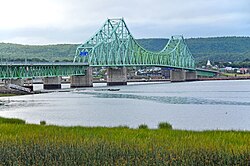Campbellton, New Brunswick
|
Campbellton "The City of Two Coasts" |
||
|---|---|---|
| City | ||
| City of Campbellton Ville de Campbellton |
||

J. C. Van Horne Bridge crossing between Campbellton and Pointe-à-la-Croix, Quebec
|
||
|
||
| Location within New Brunswick. | ||
| Coordinates: 48°00′18″N 66°40′23″W / 48.005°N 66.673056°W | ||
| Country |
|
|
| Province |
|
|
| County | Restigouche | |
| Parish | Addington | |
| Founded | 1837 | |
| Town Status | 1889 | |
| City Status | 1958 | |
|
Madawaska—Restigouche | |
| Provincial | Campbellton-Restigouche Centre | |
| Government | ||
| • Type | City Council | |
| • Mayor | Stephanie Anglehart Paulin | |
| • Councillors |
List of Members
|
|
| • CAO | Manon Cloutier | |
| Area | ||
| • City | 18.66 km2 (7.20 sq mi) | |
| • Urban | 25.41 km2 (9.81 sq mi) | |
| • Metro | 1,629.94 km2 (629.32 sq mi) | |
| • Quebec Part | 435.14 km2 (168.01 sq mi) | |
| Highest elevation | 148 m (486 ft) | |
| Lowest elevation | 0 m (0 ft) | |
| Population (2011) | ||
| • City | 7,385 | |
| • Density | 395.7/km2 (1,025/sq mi) | |
| • Urban | 11,902 | |
| • Urban density | 468.5/km2 (1,213/sq mi) | |
| • Metro | 17,842 | |
| • Metro density | 629.32/km2 (1,629.94/sq mi) | |
| • Pop 2006-2011 |
|
|
| • Dwellings | 3,654 | |
| Time zone | AST (UTC−4) | |
| • Summer (DST) | ADT (UTC−3) | |
| Postal code(s) |
|
|
| Area code(s) | 506 | |
| Highways | ||
| Median Income* | $35,168 CDN | |
| Website | www.campbellton.org | |
|
||
Campbellton is a city with a population of 7,385 (2011) in Restigouche County, New Brunswick, Canada.
Situated on the south bank of the Restigouche River opposite Pointe-à-la-Croix, Quebec, Campbellton was officially incorporated in 1889 and achieved city status in 1958.
Forestry and tourism are major industries in the regional economy, while a pulp mill in nearby Atholville is the largest single employer in the area. As part of the tourism "industry", wealthy sportfishermen seeking Atlantic Salmon flock to the scenic Restigouche Valley every summer. The region sees extensive annual snowfall. Alpine and Nordic ski facilities at Sugarloaf Provincial Park provide winter recreation opportunities for both visitors and local residents.
Campbellton is also a retail and service centre for Restigouche County.
The area around the site of the present city was settled by French people circa 1700 with a trading post based upon fishing and fur trading with the Mi'gmaq. More settlers arrived here when Ile St. Jean was lost to the French as the result of the capitulation of Louisbourg in 1758.
It was here that the Battle of the Restigouche, the final naval battle between the English and French for the possession of North America during the Seven Years' War, was waged in 1760. It marked a turning point for the settlement. Robert Ferguson and the development of Campbellton and Atholville owed their development to the enterprising immigrants from Scotland. In 1769, only nine years after the Battle of Restigouche, Scotsman Hugh Baillie and a partner set up a fur and salted salmon business on the site that would become Campbellton. The business was sold to London merchant John Shoolbred, who in 1773 established the first British settlement on the Restigouche. His agent, William Smith, brought over eight Scottish fishermen from Aberdeen, Scotland, to work for him. Two of these fishermen were John Duncan and Robert Adams, who brought their families with them as well. These two fishermen devoted themselves to the salmon fishing industry at Old Church Point, today Atholville. In 1794, a Scotsman from Perth named Alexander Ferguson settled in Martin's Point (Campbellton), where his brother Robert joined him two years later. From 1760 to 1833 the settlement went through a series of names such as; Pointe-des-Sauvages, Pointe-Rochelle and Martin's Point before Robert Ferguson provided it with its present name Campbellton, in honour of Lieutenant-Governor Sir Archibald Campbell.
...
Wikipedia


